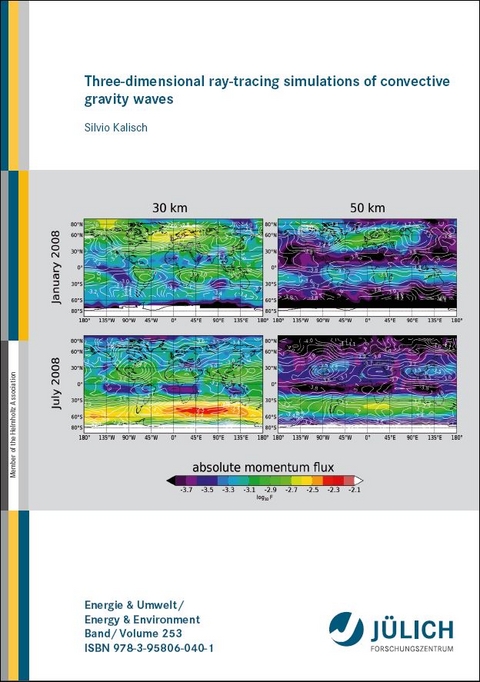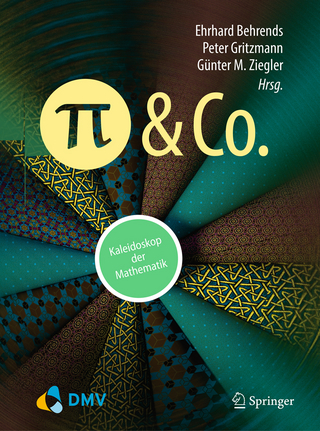
Three-dimensional ray-tracing simulations of convective gravity waves
Seiten
2015
Forschungszentrum Jülich (Verlag)
978-3-95806-040-1 (ISBN)
Forschungszentrum Jülich (Verlag)
978-3-95806-040-1 (ISBN)
- Keine Verlagsinformationen verfügbar
- Artikel merken
Due to their importance for large-scale circulations and their contribution
to the energy and momentum budget of the middle atmosphere,
gravity waves have been subject of investigation for many
in-situ and satellite measurements. These observations show that
the horizontal wavelength of a gravity wave can be as short as a
few kilometers, hence, they cannot be directly resolved by General
Circulation Models (GCM)s. For this reason, their propagation
and interaction with the background atmosphere have to be
parametrized. These gravity wave parametrizations play an important
role in state-of-the-art GCMs as they contribute to the energy
and momentum budget of the middle atmosphere and directly influence
the model dynamics. For technical reasons, most gravity
wave parametrizations restrict the propagation of gravity waves to
the vertical direction. Consequently, modeled distributions of momentum
flux and gravity wave drag show remarkable deviations from
the three-dimensional propagation as shown in this thesis. The most
obvious differences found in the three-dimensional case are the poleward
directed meridional drag and the shift of the zonal drag maximum
towards higher latitudes in the winter hemisphere. Another
simplification of gravity wave parametrizations is the homogeneous
and isotropic non-orographic launch distribution, which is unable to
resolve single gravity wave sources. Due to their importance for large-scale circulations and their contribution
to the energy and momentum budget of the middle atmosphere,
gravity waves have been subject of investigation for many
in-situ and satellite measurements. These observations show that
the horizontal wavelength of a gravity wave can be as short as a
few kilometers, hence, they cannot be directly resolved by General
Circulation Models (GCM)s. For this reason, their propagation
and interaction with the background atmosphere have to be
parametrized. These gravity wave parametrizations play an important
role in state-of-the-art GCMs as they contribute to the energy
and momentum budget of the middle atmosphere and directly influence
the model dynamics. For technical reasons, most gravity
wave parametrizations restrict the propagation of gravity waves to
the vertical direction. Consequently, modeled distributions of momentum
flux and gravity wave drag show remarkable deviations from
the three-dimensional propagation as shown in this thesis. The most
obvious differences found in the three-dimensional case are the poleward
directed meridional drag and the shift of the zonal drag maximum
towards higher latitudes in the winter hemisphere. Another
simplification of gravity wave parametrizations is the homogeneous
and isotropic non-orographic launch distribution, which is unable to
resolve single gravity wave sources.
to the energy and momentum budget of the middle atmosphere,
gravity waves have been subject of investigation for many
in-situ and satellite measurements. These observations show that
the horizontal wavelength of a gravity wave can be as short as a
few kilometers, hence, they cannot be directly resolved by General
Circulation Models (GCM)s. For this reason, their propagation
and interaction with the background atmosphere have to be
parametrized. These gravity wave parametrizations play an important
role in state-of-the-art GCMs as they contribute to the energy
and momentum budget of the middle atmosphere and directly influence
the model dynamics. For technical reasons, most gravity
wave parametrizations restrict the propagation of gravity waves to
the vertical direction. Consequently, modeled distributions of momentum
flux and gravity wave drag show remarkable deviations from
the three-dimensional propagation as shown in this thesis. The most
obvious differences found in the three-dimensional case are the poleward
directed meridional drag and the shift of the zonal drag maximum
towards higher latitudes in the winter hemisphere. Another
simplification of gravity wave parametrizations is the homogeneous
and isotropic non-orographic launch distribution, which is unable to
resolve single gravity wave sources. Due to their importance for large-scale circulations and their contribution
to the energy and momentum budget of the middle atmosphere,
gravity waves have been subject of investigation for many
in-situ and satellite measurements. These observations show that
the horizontal wavelength of a gravity wave can be as short as a
few kilometers, hence, they cannot be directly resolved by General
Circulation Models (GCM)s. For this reason, their propagation
and interaction with the background atmosphere have to be
parametrized. These gravity wave parametrizations play an important
role in state-of-the-art GCMs as they contribute to the energy
and momentum budget of the middle atmosphere and directly influence
the model dynamics. For technical reasons, most gravity
wave parametrizations restrict the propagation of gravity waves to
the vertical direction. Consequently, modeled distributions of momentum
flux and gravity wave drag show remarkable deviations from
the three-dimensional propagation as shown in this thesis. The most
obvious differences found in the three-dimensional case are the poleward
directed meridional drag and the shift of the zonal drag maximum
towards higher latitudes in the winter hemisphere. Another
simplification of gravity wave parametrizations is the homogeneous
and isotropic non-orographic launch distribution, which is unable to
resolve single gravity wave sources.
| Sprache | englisch |
|---|---|
| Einbandart | Paperback |
| Themenwelt | Sachbuch/Ratgeber ► Natur / Technik ► Naturwissenschaft |
| Schlagworte | Atmosphere • GCM • Gravity waves |
| ISBN-10 | 3-95806-040-4 / 3958060404 |
| ISBN-13 | 978-3-95806-040-1 / 9783958060401 |
| Zustand | Neuware |
| Haben Sie eine Frage zum Produkt? |
Mehr entdecken
aus dem Bereich
aus dem Bereich
Der gesunde Weg aus dem Müdigkeitslabyrinth – Mit …
Buch | Softcover (2023)
dtv Verlagsgesellschaft
15,00 €
*Unsere Teilchen aber schon : ein Reiseführer durch die Welt der …
Buch | Hardcover (2023)
Brandstätter Verlag
25,00 €


